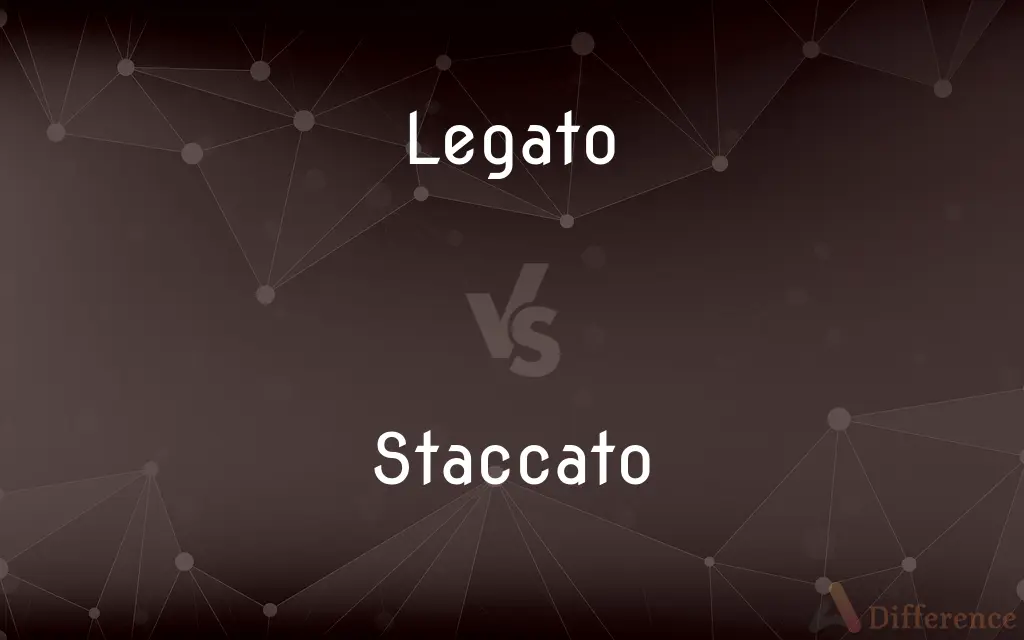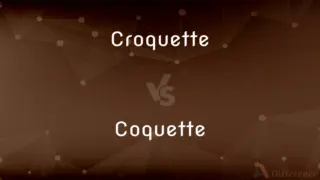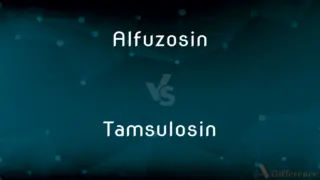Legato vs. Staccato — What's the Difference?
By Maham Liaqat & Urooj Arif — Updated on March 28, 2024
Legato signifies smooth and connected notes in music, while staccato indicates detached, sharply separated notes.

Difference Between Legato and Staccato
Table of Contents
ADVERTISEMENT
Key Differences
Legato, in music, is a directive to play notes in a smooth, flowing manner without noticeable gaps. This technique involves playing notes so that each one connects directly to the next, creating a seamless sound. On the other hand, staccato is a playing style where notes are performed in a detached, separated manner, with each note being sharply distinct from the others, creating a crisp and concise effect.
The legato technique is often symbolized in sheet music by a curved line connecting the notes that should be played smoothly. This symbol, called a slur, indicates that the notes under it should be played as one continuous phrase. Whereas, staccato notes are marked by small dots above or below the notes, instructing the performer to play the notes short and detached, emphasizing the break between each note.
Legato is frequently used in strings, wind instruments, and vocal music to emphasize lyrical passages and melodies that benefit from a connected, flowing sound. It's particularly effective in expressing emotional depth and sustaining musical phrases. Staccato, in contrast, is utilized to add rhythm, articulation, and excitement to the music, making it ideal for lively, dynamic, and rhythmic passages.
While legato play requires careful control of breath, bowing, or finger movements to ensure smooth transitions between notes, staccato demands precise, controlled movements to achieve clear separation. This distinction highlights the different techniques and skills instrumentalists must master to effectively execute each style.
In terms of effect, legato contributes to a song's melody by creating lines that flow together seamlessly, often used to evoke a sense of calmness or fluidity. Staccato, however, adds texture and rhythm to the music, creating a more punctuated, energetic, and sometimes playful character.
ADVERTISEMENT
Comparison Chart
Definition
Smooth and connected notes
Detached and sharply separated notes
Symbol
Curved line (slur) connecting notes
Small dots above or below notes
Used in
Lyrical passages and melodies
Rhythmic passages and articulation
Technique
Continuous, flowing movement
Short, precise movements
Effect
Creates a seamless sound, evoking fluidity
Adds texture and rhythm, creating energy
Compare with Definitions
Legato
A musical direction indicating that notes should be played smoothly and connectedly.
The violinist's legato technique gave the piece an ethereal quality.
Staccato
A direction in music performance indicating that notes should be played in a detached, separated manner.
The staccato notes in the march added to its brisk feel.
Legato
A style of singing or playing that emphasizes fluidity.
He applied legato to the melody to enhance its emotional impact.
Staccato
A style of musical articulation that emphasizes separation between notes.
The piece requires a staccato approach to convey its playful character.
Legato
The smooth transition between notes without gaps.
Her piano playing is known for its expressive legato.
Staccato
A series of short, detached notes in a musical composition.
The composer used staccato to mimic the sound of raindrops.
Legato
A passage of music that is to be played in a smooth, flowing manner.
This section of the score is marked legato, requiring seamless transitions.
Staccato
The act of playing notes sharply and distinctly apart.
She impressed the audience with her crisp staccato technique.
Legato
The performance practice in instrumental music focusing on connectivity.
Mastering legato is essential for any aspiring cellist.
Staccato
The practice of producing sharply defined, separated sounds on a musical instrument.
His staccato on the trumpet was remarkably clear and precise.
Legato
In music performance and notation, legato ([leˈɡaːto]; Italian for "tied together"; French lié; German gebunden) indicates that musical notes are played or sung smoothly and connected. That is, the player makes a transition from note to note with no intervening silence.
Staccato
Staccato ([stakˈkaːto]; Italian for "detached") is a form of musical articulation. In modern notation, it signifies a note of shortened duration, separated from the note that may follow by silence.
Legato
In a smooth, even style without any noticeable break between the notes. Used chiefly as a direction.
Staccato
(Music) Cut short crisply; detached
Staccato octaves.
Legato
A legato passage or movement.
Staccato
Marked by or composed of abrupt, disconnected parts or sounds
Staccato applause.
Legato
(music) Smoothly, in a connected manner.
Play this passage legato, not portato.
Staccato
A staccato manner or sound.
Legato
(music) A style of performance characterized by smoothly connected notes.
Staccato
(music) An articulation marking directing that a note or passage of notes are to be played in an abruptly disconnected manner, with each note sounding for a very short duration, and a short break lasting until the sounding of the next note; as opposed to legato. Staccato is indicated by a dot directly above or below the notehead.
Legato
(music) A passage that is played legato.
Staccato
(music) A passage having this mark.
Legato
Connected; tied; - a term used when successive tones are to be produced in a closely connected, smoothly gliding manner. It is often indicated by a tie, thus , , or , , written over or under the notes to be so performed; - opposed to staccato.
Staccato
(figurative) Any sound resembling a musical staccato.
Legato
Without breaks between notes; smooth and connected;
A legato passage
Staccato
(music) played in this style
Now, play the same passage very staccato.
Legato
Connecting the notes; in music;
Play this legato, please
Staccato
(music) Describing a passage having this mark.
Staccato
Made up of abruptly disconnected parts or sounds.
Staccato
Disconnected; separated; distinct; - a direction to perform the notes of a passage in a short, distinct, and pointed manner. It is opposed to legato, and often indicated by heavy accents written over or under the notes, or by dots when the performance is to be less distinct and emphatic.
Staccato
Expressed in a brief, pointed manner.
Staccato and peremptory [literary criticism].
Staccato
Marked by or composed of disconnected parts or sounds; cut short crisply;
Staccato applause
A staccato command
Staccato notes
Staccato
Separating the notes; in music;
Play this staccato, please
Common Curiosities
What does staccato mean in music?
Staccato means playing notes in a detached, sharply separated manner.
How do you identify legato in sheet music?
Legato is identified by a curved line (slur) connecting the notes to be played smoothly.
What is legato?
Legato is a musical term indicating that notes should be played smoothly and connectedly.
What is the purpose of staccato in music?
The purpose of staccato is to add rhythm, articulation, and excitement to music by playing notes shortly and detachedly.
Which is easier to play, legato or staccato?
The difficulty depends on the context and the performer's skill; both require specific techniques and practice.
Can vocalists use legato?
Yes, vocalists use legato to sing notes in a smooth, connected manner, often to convey emotion or lyrical beauty.
Can legato and staccato be used together in a piece?
Yes, composers often use both legato and staccato in a single piece to create contrast and interest.
Do all musical genres use legato and staccato?
While not all genres use them explicitly, legato and staccato techniques are applicable across a wide range of musical styles.
Do pianists use staccato?
Yes, pianists use staccato to play notes in a detached manner, adding clarity and rhythm to their performance.
What role does staccato play in rhythm?
Staccato plays a crucial role in defining rhythm by creating clear, punctuated patterns that add energy and texture to the music.
What is the difference between staccato and accent?
Staccato focuses on playing notes shortly and detachedly, while an accent emphasizes a note's attack, making it stand out within a passage.
How do you practice legato?
Practicing legato involves focusing on smooth, connected transitions between notes, often requiring control of breath or finger movements.
Is legato only for string instruments?
No, legato can be applied to a wide range of instruments, including wind instruments and vocals.
How does legato affect a musical piece?
Legato affects a musical piece by creating smooth, flowing lines that enhance its lyrical and emotional qualities.
Is staccato a type of musical notation?
Yes, staccato is a type of musical notation indicated by dots, guiding performers on how to articulate notes.
Share Your Discovery

Previous Comparison
Croquette vs. Coquette
Next Comparison
Alfuzosin vs. TamsulosinAuthor Spotlight
Written by
Maham LiaqatCo-written by
Urooj ArifUrooj is a skilled content writer at Ask Difference, known for her exceptional ability to simplify complex topics into engaging and informative content. With a passion for research and a flair for clear, concise writing, she consistently delivers articles that resonate with our diverse audience.















































